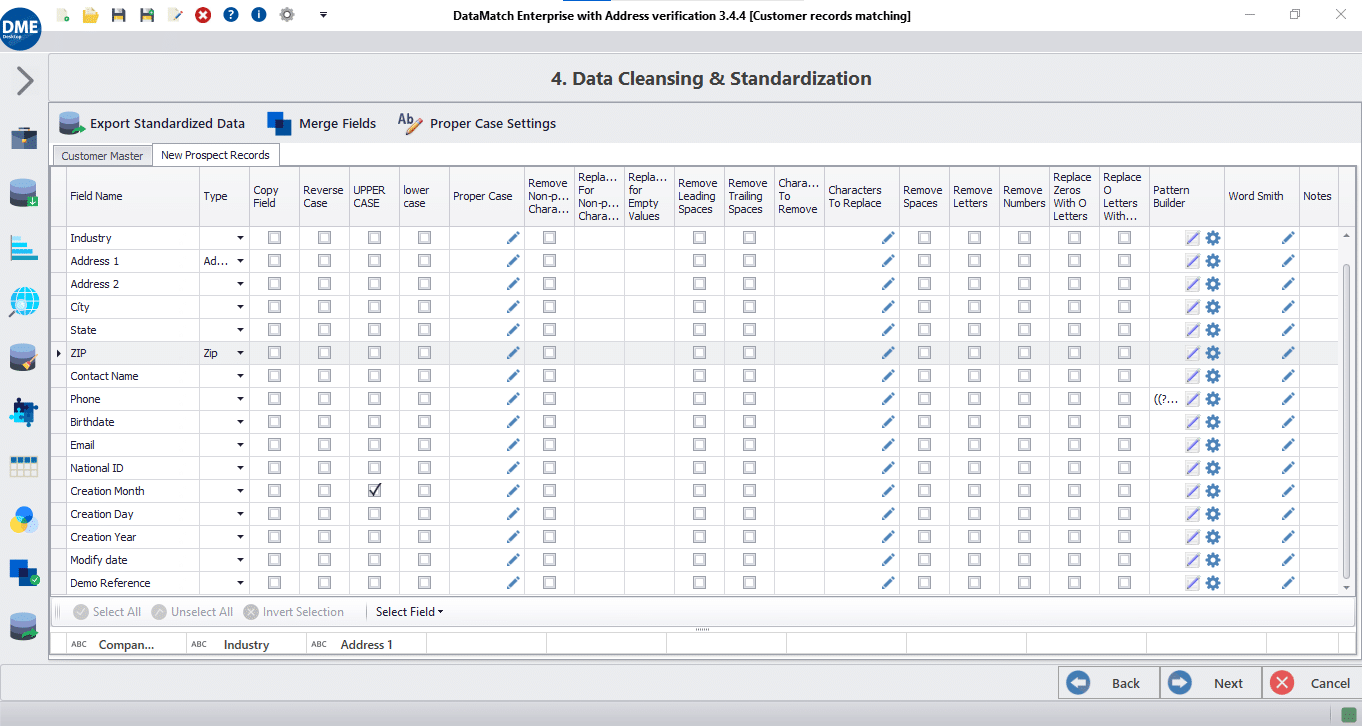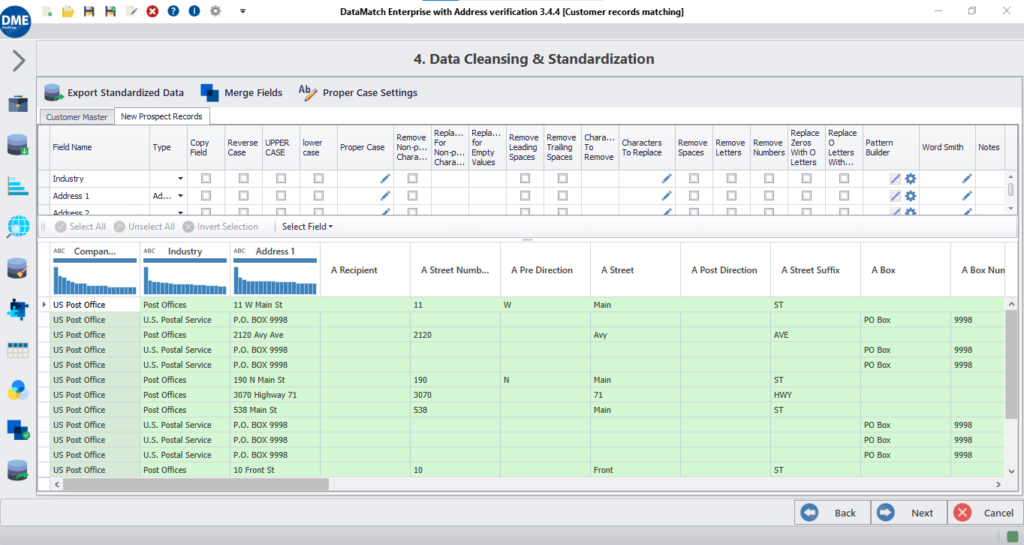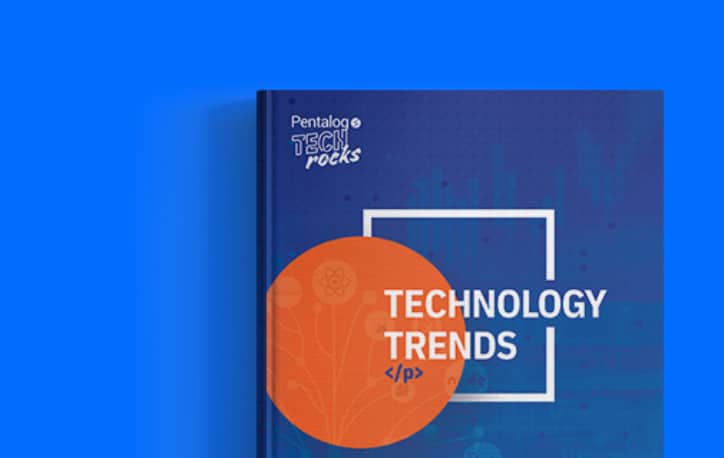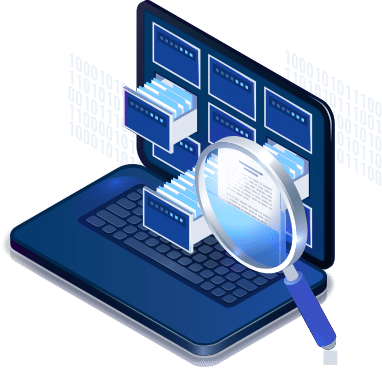Data cleansing software
Our data cleansing tool is feature-rich solution that helps you to eliminate inconsistent and invalid values, create and validate patterns, and achieve a standardized view across all data sources, ensuring high data quality, accuracy, and usability.

Trusted By





Trusted By






DEFINiTION
What is a data cleansing tool?
A data cleansing tool is a solution that helps eliminate incorrect and invalid information from a dataset, and achieve a consistent and usable view across all data sources. Some common data cleansing and standardization activities include:
- Removing and replacing empty or garbage values,
- Parsing aggregated columns to identify smaller sub-components,
- Transforming letter cases,
- Merging the same or similar columns together to avoid duplicates,
- Transforming values to follow the correct pattern and format,
- Flagging, replacing, or eliminating the most repetitive words in a column to remove noise in bulk.
Benefits
Why do you need a data cleansing tool?
Keep your data error-free
Remove missing, incomplete, and invalid values to avoid major roadblocks in the execution of business processes.
Preserve data usability
Presence of data doesn’t guarantee data usability; improve data adaptability with a clean and standardized dataset.
Benefit from data-driven initiatives
Make the best decisions for your business by using clean and reliable data sources and gain true business insights.
Ensure data compliance
Ensure that your data management strategies comply to data compliance standards, such as such as GDPR, HIPAA, CCPA, etc.
Improve brand loyalty
Perform CRM data cleansing and leverage accurate information to offer personalized experiences to customers.
Stay relevant and up-to-date
Run quick data quality checks with an easy-to-use and inexpensive data cleansing tool for staying relevant and up-to-date.
Features
What DME’s data cleansing tool can do for you?

There’s more
What else do you get out of the box?
Our data cleansing solution comes with a number of in-built features that facilitate easy, automatic, and cost-effective data cleansing operations at any time.
- Live preview of cleansed data
- Data type identification
- Pre-built & custom patterns
- Scheduler for automatic data cleansing
- Proper case transformation
- Dictionary of common words
- Custom filters for personalized view
- Multi-format support for exporting results
User roles
A tool made for everyone

Data analysts

Business users

IT Professionals

Novice users
Features
We take care of your complete DQM lifecycle
Import
Connect and integrate data from multiple disparate sources

Profiling
Automate data quality checks and get instant data profile reports

Cleansing
Standardize & transform datasets through various operations

Matching
Execute industry-grade data match algorithms on datasets

Deduplication
Eliminate duplicate values and records to preserve uniqueness

Merge & purge
Configure merge and survivorship rules to get the most out of data
Want to know more?
Check out DME resources

Merging Data from Multiple Sources – Challenges and Solutions
Oops! We could not locate your form.

Big Data Analytics Is Booming – But Is Your Data Ready for It?
Amazon generates 35% of its revenue from data-powered recommendations. Netflix enjoys an 89% retention rate by personalizing every experience using viewer behavior, preferences, and interaction

Data Ethics in the Age of AI: Why Responsible Matching Matters More Than Ever
When AI systems deliver inaccurate or inequitable results, many people immediately assume that something went wrong in the algorithms. Rarely do we look upstream –

Big Data Analytics Is Booming – But Is Your Data Ready for It?
Amazon generates 35% of its revenue from data-powered recommendations. Netflix enjoys an 89% retention rate by personalizing every experience using viewer behavior, preferences, and interaction

Data Ethics in the Age of AI: Why Responsible Matching Matters More Than Ever
When AI systems deliver inaccurate or inequitable results, many people immediately assume that something went wrong in the algorithms. Rarely do we look upstream –

Why Data Interoperability Challenges Are Holding Back Your Insights – And What to Do About It
Every modern organization thinks it’s interoperable—until the data says otherwise. Your systems are technically connected. APIs are firing. Data is flowing. But when you zoom







































